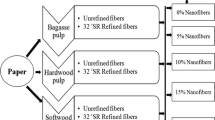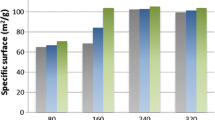Abstract
Extending the use of mechanical pulp into non-traditional paper markets that requires moving towards producing high-bulk, porous paper grades with sufficient strength has gained intensive interest. This paper explores the potential of incorporating fiber fractionation with microfibril production to create high-bulk, porous, and strong enough material appropriate for a wide range of non-traditional mechanical pulp applications. Two different pressure-screen fractionation trials were conducted to fractionate a primary pulp into a long and coarse fiber stream (reject) and a fine and short fiber stream (accept). High-bulk, low-tensile sheets were obtained using the long and coarse reject fibers. The accept fibers were low-consistency refined at high specific energy to produce a microfibrilated cellulose (MFC) material and used to strengthen the high-bulk reject pulp sheets. The results illuminated that incorporating highly refined accept fibers having MFC-mimetic network into the paper structure could be a promising route to engineer the paper properties and extend the property range in comparison to low consistency refined whole pulp. Different series of handsheets were made and systematically studied by means of fiber length, fine percentage, bulk, tensile index, tensile energy absorption, Tear and burst indices, and freeness. Moreover, SEM micrographs were used to interpret the variations of paper properties. We believe that our results shed light on future mechanical pulp materials suitable for packaging and absorbency grades of paper that are high-bulk with sufficient strength for the specific application.










Similar content being viewed by others
Data availability
Data is available on request from the corresponding author on reasonable request.
References
Adel AM, El-Gendy AA, Diab MA, Abou-Zeid RE, El-Zawawy WK, Dufresne A (2016) Microfibrillated cellulose from agricultural residues. Part I: papermaking application. Ind Crops Prod 93:161–174
Aigner M (2021) Bar force profiles in LC refining
Anderssou S, Sandberg C, Engstrand P (2012) Mechanical pulping. Effect of long fibre concentration on low consistency refining of mechanical pulp. Nord Pulp Pap Res J 27(4):702–706
Berna JER, Sandberg C, Martinez M, Olson J (2019) Theoretical analysis of LC-refining–pressure screening systems in TMP. Nord Pulp Pap Res J 34(1):46–58
Bharimalla AK, Deshmukh SP, Patil PG, Nadanathangam V (2017) Micro/nano-fibrillated cellulose from cotton linters as strength additive in unbleached kraft paper: Experimental, semi-empirical, and mechanistic studies. BioResources 12(3):5682–5696
Bilek MA, Salem HJ, Korehei R, Olson JA (2021) Recycling paper-plastic laminate coffee cups using a single-disk refiner: energy requirements and recovered fiber quality. Waste Manag 136:104–112
Boufi S, González I, Delgado-Aguilar M, Tarres Q, Pèlach M, Mutje P (2016) Nanofibrillated cellulose as an additive in papermaking process: a review. Carbohydr Polym 154:151–166
Dutt D, Mishra A, Kumar A, Mishra NC (2012) Cost reduction and upgrading of basic properties of absorbent-grade paper. BioResources 7(3):3125–3131
Elahimehr A (2014) Low consistency refining of mechanical pulp: the relationship between plate pattern, operational variables and pulp properties. University of British Columbia
Elahimehr A, Olson JA, Martinez DM (2015) Low consistency refining of mechanical pulp: how plate pattern and refiner operating conditions change the final properties of pulp. Nord Pulp Pap Res J 30(4):609–616
Eriksen O, Hammar L-Ã (2007) Refining mechanisms and development of TMP properties in a low-consistency refiner. In: Paper presented at the International Mechanical Publishing Conference, Minneapolis, MN, USA
Eriksen Ø, Syverud K, Gregersen Ø (2008) The use of microfibrillated cellulose produced from kraft pulp as strength enhancer in TMP paper. Nord Pulp Pap Res J 23(3):299–304
Ettefagh HH (2016) Application of low consistency refining of pulp in producing multi-ply folding boxboards. University of Toronto, Canada
Fernandez FJ, Martinez DM, Olson JA (2018) Investigation of low consistency reject refining of mechanical pulp for energy savings. Nord Pulp Pap Res J 33(1):21–27
Fernando D, Gorski D, Sabourin M, Daniel G (2013) Characterization of fiber development in high-and low-consistency refining of primary mechanical pulp. Holzforschung 67(7):735–745
Gharehkhani S, Sadeghinezhad E, Kazi SN, Yarmand H, Badarudin A, Safaei MR, Zubir MNM (2015) Basic effects of pulp refining on fiber properties—a review. Carbohydr Polym 115:785–803
Ghose A, Chinga-Carrasco G (2013) Environmental aspects of norwegian production of pulp fibres and printing paper. J Clean Prod 57:293–301
González I, Boufi S, Pèlach MA, Alcalà M, Vilaseca F, Mutjé P (2012) Nanofibrillated cellulose as paper additive in eucalyptus pulps. BioResources 7(4):5167–5180
Hafrén J, Fernando D, Gorski D, Daniel G, Salomons FA (2014) Fiber-and fine fractions-derived effects on pulp quality as a result of mechanical pulp refining consistency. Wood Sci Technol 48(4):737–753
Hassan EA, Hassan ML, Oksman K (2011) Improving bagasse pulp paper sheet properties with microfibrillated cellulose isolated from xylanase-treated bagasse. Wood Fiber Sci 76–82
Jahangir ES, Olson JA (2020) Low consistency refined ligno-cellulose microfibre: an MFC alternative for high bulk, tear and tensile mechanical pulp papers. Cellulose 27(5):2803–2816
Jele TB, Lekha P, Sithole B (2021) Role of cellulose nanofibrils in improving the strength properties of paper: a review. Cellulose 1–27
Johansson A (2011) Correlations between fiber properties and paper properties. Master Thesis. KTH Royal Institute of Technology, Stockholm, Sweden
Jonoobi M, Mathew AP, Oksman K (2012) Producing low-cost cellulose nanofiber from sludge as new source of raw materials. Ind Crops Prod 40:232–238
Kargupta W, Seifert R, Martinez M, Olson J, Tanner J, Batchelor W (2021) Sustainable production process of mechanically prepared nanocellulose from hardwood and softwood: a comparative investigation of refining energy consumption at laboratory and pilot scale. Ind Crops Prod 171:113868
Kerekes R (2010) Energy and forces in refining. J Pulp Pap Sci 36(1):10
Kordi T (2018) Effect of low consistency refining and fractionation on folding boxboards and discrete element modelling of Plybond Strength. University of Toronto, Canada
Lavoine N, Desloges I, Dufresne A, Bras J (2012) Microfibrillated cellulose–its barrier properties and applications in cellulosic materials: a review. Carbohydr Polym 90(2):735–764
Lemrini M-M, Lanouette R, Michaud G (2015) Merging interstage fractionation and low consistency advantages during the TMP refining process: part III–How fibre morphology impacts paper properties. BioResources 10(1):1048–1059
Luukkonen A (2011) Development of a methodology to optimize low consistency refining of mechanical pulp. University of British Columbia Vancouver, Canada
Miller M, Olson JA, Luukkonen A (2017) Effect of LC refining intensity on fractionated and unfractionated mechanical pulp. Nord Pulp Pap Res J 32(3):386–394
Morais FP, Carta AM, Amaral ME, Curto JM (2021) Micro/nano-fibrillated cellulose (MFC/NFC) fibers as an additive to maximize eucalyptus fibers on tissue paper production. Cellulose 28(10):6587–6605
Motamedian HR, Halilovic AE, Kulachenko A (2019) Mechanisms of strength and stiffness improvement of paper after PFI refining with a focus on the effect of fines. Cellulose 26(6):4099–4124
Muchorski D (2006) Tensile properties of paper and paperboard using constant rate of elongation apparatus, revision of T 494 om-01. In: Standard-Specific Interest Group Approved Test Method
Odabas N, Henniges U, Potthast A, Rosenau T (2016) Cellulosic fines: Properties and effects. Prog Mater Sci 83:574–594
Olson J (2001) Fibre length fractionation caused by pulp screening, slotted screen plates. J Pulp Pap Sci 27(8):255–261
om-04 TT (2004) Freeness of pulp. In: Tappi Press Atlanta
Osong SH, Norgren S, Engstrand P (2013) An approach to produce nano-ligno-cellulose from mechanical pulp fine materials. Nord Pulp Pap Res J 28(4):472–479
Osong SH, Norgren S, Engstrand P (2016) Processing of wood-based microfibrillated cellulose and nanofibrillated cellulose, and applications relating to papermaking: a review. Cellulose 23(1):93–123
Sandberg C, Berg J-E, Engstrand P (2017) Mill evaluation of an intensified mechanical pulping process. Nord Pulp Pap Res J 32(2):204–210
Sandberg C, Hill J, Jackson M (2020) On the development of the refiner mechanical pulping process–a review. Nord Pulp Pap Res J 35(1):1–17
Shafiei-Sabet S, Martinez M, Olson J (2016) Shear rheology of micro-fibrillar cellulose aqueous suspensions. Cellulose 23(5):2943–2953
Shallhorn P, Gurnagul N (2010) A semi-empirical model of the tensile energy absorption of sack kraft paper. BioResources 5(1):455–476
Sirvio J, Nurminen I (2004) Systematic changes in paper properties caused by fines. Pulp and paper Cananda-Ontario-, 105:39–42
sp-02 T (2002) s. T. Forming handsheets for physical tests of pulp. In: Tappi Press Atlanta, GA
Su J, Mosse WK, Sharman S, Batchelor WJ, Garnier G (2013) Effect of tethered and free microfibrillated cellulose (MFC) on the properties of paper composites. Cellulose 20(4):1925–1935
Tappi N (2013) Standard conditioning and testing atmospheres for paper, board, pulp handsheets, and related products. TAPPI T402 Sp-08
Tian H, Lu Q, Gopaluni RB, Zavala VM, Olson JA (2019) An economic model predictive control framework for mechanical pulping processes. Control Eng Pract 85:100–109
Varanasi S, Batchelor WJ (2013) Rapid preparation of cellulose nanofibre sheet. Cellulose 20(1):211–215
Venditti RA (2017) https://faculty.cnr.ncsu.edu/richardvenditti/wp-content/uploads/sites/24/2018/10/PaperGrades-Venditti.pdf
Zeng J, Zeng Z, Cheng Z, Wang Y, Wang X, Wang B, Gao W (2021) Cellulose nanofibrils manufactured by various methods with application as paper strength additives. Sci Rep 11(1):1–16
Acknowledgments
This work was conducted as part of the Energy Reduction in Mechanical Pulping program. and the following partners: We greatly thank for the ongoing support of the following partners: AB Enzymes, Alberta Newsprint Company, BC Hydro, BC Institute of Technology, Canfor, Paper Excellence, FPInnovations, Holmen Paper, McMaster University, Millar Western, The University of British Columbia Pulp and Paper Centre, University of Victoria, West Fraser, and Valmet. We also gratefully acknowledge Quesnel River Pulp (West Fraser) for providing the pulp for these trials and UBC Bioimaging Facility for allowing us to use their resources. A special thanks to George Soong and Michael Bilek at UBC Pulp and Paper Centre for their support during this work.
Funding
This work was funded by a Collaborative Research and Development Grant provided by the Natural Sciences and Engineering Research Council of Canada (NSERC) (Grant No. CRDPJ 538628-19).
Author information
Authors and Affiliations
Contributions
RS and SG contributed equally. All authors contributed to the study conception and design. Material preparation and data collection were performed by RS, DF, and JM. Data analysis was performed by RS, SG, and JO. The first draft of the manuscript was written by SG. The manuscript was critically reviewed by JO. The other authors also commented on previous versions of the manuscript.
Corresponding authors
Ethics declarations
Conflict of interest
The authors have no relevant financial or non-financial interests to disclose.
Ethical approval
Not applicable.
Consent to participate
Not applicable.
Consent for publication
All the authors agreed with the publication of the present manuscript in Cellulose.
Additional information
Publisher’s Note
Springer Nature remains neutral with regard to jurisdictional claims in published maps and institutional affiliations.
Rights and permissions
Springer Nature or its licensor (e.g. a society or other partner) holds exclusive rights to this article under a publishing agreement with the author(s) or other rightsholder(s); author self-archiving of the accepted manuscript version of this article is solely governed by the terms of such publishing agreement and applicable law.
About this article
Cite this article
Seifert, R., Gharehkhani, S., Vargas Figueroa, D. et al. Engineering the paper production by combined fiber fractionation and reinforcement with microfibrillated cellulose. Cellulose 30, 3201–3217 (2023). https://doi.org/10.1007/s10570-023-05053-7
Received:
Accepted:
Published:
Issue Date:
DOI: https://doi.org/10.1007/s10570-023-05053-7




